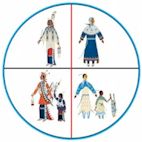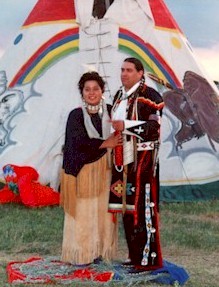



![]()
Dakota Conflict of 1862 - Teacher Page
A WebQuest for 6th-8th Grade (Social Studies)
Designed by Anthony Shields
Introduction | Learners | Curriculum Standards | The Process
Entry Level Skills | Resources Needed | Evaluation | Conclusion | Credits
This 'Dakota Conflict' webquest is available here for people of all ages to learn about a moment in time of our U.S. history, that hopefully will be discussed in the classroom. This webquest was made for further inquiry / investigations of the American Indians, the Dakota, and specifically the Dakota Conflict of 1862 (aka, the Sioux Uprising of 1862).
This webquest is a multidisciplinary unit about the Sioux Uprising of 1862 and the events and issues that led up to it in the time period of 1851 - 1862. It is intended to be a culminating activity to be used within the study of the Sioux Uprising of 1862, where the final student created product will be a newspaper article. Students may use encyclopedias, library resources, and any other material they can find, and more immediate, the Internet. The final form of the newspaper can be done on broadsheet for classroom display, word processed on the computer, presented with PowerPoint, or done as a web page.
Please have an open mind, and thank you.
 Posted
by: Anthony Shields, Fort Peck Dakota, Ihanktowan - A professor of
computer science at Fort
Peck Community College. This
lesson was developed as part of a Lesley
University Technology in Education Graduate Program course.
Posted
by: Anthony Shields, Fort Peck Dakota, Ihanktowan - A professor of
computer science at Fort
Peck Community College. This
lesson was developed as part of a Lesley
University Technology in Education Graduate Program course.
Learners
This webquest lesson is anchored in sixth, seventh, and eighth grade social studies and involves U.S. history and journalism as well. The unit is designed for middle school grade levels, but can easily be extended to high school students.
To live, learn, and work successfully in an increasingly complex and information-rich society, students must be able to use technology effectively. Within an effective educational setting, technology can enable students to become:
- Capable information technology users.
- Information seekers, analyzers, and evaluators.
- Problem solvers and decision makers.
- Creative and effective users of productivity tools.
- Communicators, collaborators, publishers, and producers.
- Informed, responsible, and contributing citizens (ISTE.org, 2002).
The ability to use these skills will greatly influence students' success in school, in the workplace and in the community.
Students who finish the Dakota Conflict WebQuest will become skilled learners, where the following technology outcomes should occur (NETS for Students).
Social Studies Standards: Performance Expectations
The following sets of national standards describe what students should learn during their middle grades school experiences, and this webquest. Professional organizations representing educational technology, mathematics, science, social studies, English language arts, foreign languages, and information literacy have developed the following standards based on national consensus. (ISTE.org, Curriculum Standards)
- I. Culture (for middle grades)
- II. Time, Continuity, and Change (for middle grades)
- III. People, Places, and Environments (for middle grades)
- IV. Individual Development and Identity (for middle grades)
- V. Individuals, Groups, and Institutions (for middle grades)
- VI. Power, Authority, and Governance (for middle grades)
Participants should work in groups of 2, and your goal is to design, develop and present a uniquely American 'newspaper article' through connections to the world wide web learning environment. This engaged learning project will result in fulfilling International Society for Technology in Education Standards, as well as providing a multimedia, research and presentational experience for students.
Production: Dear Editor (teacher), meet regularly with your "War News' reporters to check their progress. Set intermediate deadlines (before the entire paper is due) and encourage them in their journalistic efforts. Make sure that everyone does his fair share of the work and the newspaper is the best it can be.
To reflect the issues concerning the Sioux Uprising of 1862, have your reporters interview Dakota men and women for the other side of the story. There are many different roles, or jobs in publishing a newspaper, but the size of the student groups (2 ea.) can be adapted according to the size of the class. Internet access at home should be one criteria for establishing the student groups. To maximize class time and to insure authentic assessment, the requirements and format of this activity should be discussed at the beginning of the Dakota Conflict WebQuest project. This would be an appropriate time to include student input during the introduction of the evaluation rubric. Class time devoted to this activity depends upon how each individual teacher decides to structure the project.
Things to think about before the start of this activity:
- Contact school library media specialist to schedule library research time and to enlist help in locating resources.
- Send assignment alerts to local libraries.
- Schedule computer lab time or plan times for computer use for each group.
- Survey students to find out home internet access and computer skills to aid in forming equitable groups.
- Decide on the final format of the paper, such as large broadsheet, PowerPoint, Word document, web page, or something.
Students will need to have basic research skills. Students will need to know how to:
- Access information in a library and on the Internet.
- Take notes.
- Cite sources in correct format.
- Write a basic newspaper article (Make sure you read this first!).
- Work cooperatively in groups.
Students will need background knowledge of the geography and issues of Minnesota in the years preceding the Sioux Uprising of 1862, and after.
The teacher facilitating this webquest should visit all of the hyperlinks, videos, etc. there on the 'Student Page/The Process,' and read all of the content in those webpages for assurance.
Teachers will need to have a comfort level with computers and the Internet or have someone assisting them who does.
Resources Needed
Students are encouraged to begin with the information available in their classroom and expand to material in the school and local libraries, or it may be accomplished using the Internet. This activity lends itself well to team teaching, but can be accomplished by an individual teacher. Some of the possibilities:
- Class sets of textbooks
- E-mail accounts for all students (sharing of information: i.e, URLs, text, .jpg images, .gif images, etc.)
- Internet Explorer 5.5 and above; Netscape Communicator 6 and above; Microsoft Word 2000 (PC or MAC); Notepad (PC); Simpletext (MAC)
- One Internet connected PC or MAC per group (2 students per group); headphones, or speakers; Media Player 7.1 (PC or MAC)
- Specific U.S. History reference material in the classroom or school library
- Video or audio materials
Links used in this webquest, in no particular order:
The Dakota Exile - http://www.ktca.org/dakota/index.html
Minnesota Map/Quiz Printout - http://www.enchantedlearning.com/usa/statesbw/minnesota.shtml
Wood Lake Minnesota - http://www.americancivilwar.com/statepic/mn/mn002.html
Fort Ridgely Minnesota - http://www.americancivilwar.com/statepic/mn/mn001.html
United States Historical Census Data Browser - http://fisher.lib.virginia.edu/census/
ISTE: National Educational Technology Standards - http://cnets.iste.org/
MHS Territory Exhibit - http://www.mnhs.org/places/historycenter/exhibits/territory/index.html
MHS Visual Resource Database - http://collections.mnhs.org/visualresources/
TPT Productions: Dakota Exile - http://tpt.org/dakota/index.html
Videofinders.com - Dakota Conflict, Dakota Exile - too long of an URL to post
The Dakota Conflict Trials of 1862 - http://www.law.umkc.edu/faculty/projects/ftrials/dakota/dakota.html
Cartoon History of the Sioux Uprising of 1862 - http://www.law.umkc.edu/faculty/projects/ftrials/dakota/Cartoon1.html
Chronology of the Sioux Uprising of 1862 - http://www.law.umkc.edu/faculty/projects/ftrials/dakota/dak_chrono.html
Dakota Conflict - Maps - http://www.law.umkc.edu/faculty/projects/ftrials/dakota/DakMAP1862.html
My History is America's History - Surviving the Dakota Conflict of 1862 http://www.myhistory.org/yourstories/AprilMay2001/dakotaconflict.html
Evaluation
Use this rubric to evaluate your student's efforts during the completion of this WebQuest:
| Beginning | Developing | Accomplished | Exemplary | Score | |
| 1 | 2 | 3 | 4 | ||
| Followed links successfully | Unable to follow links. | Followed links with assistance. | Followed links independently. | Followed links and assisted others. | |
| Recorded observations | Took few notes while browsing. | Took some notes while browsing. | Took detailed notes while browsing. | Took detailed notes with many specific examples. | |
Worked cooperatively |
Worked independently. | Divided tasks and shared some responsibilities. | Shared responsibility and aided group effort. | Aided group effort. Divided roles. Common vision. | |
| Managed time wisely | No understanding of time constraints. Wasted time. | Little understanding of time constraints. Wasted some time. | Understood and worked within time constraints. | Understood time constraints. Worked efficiently. | |
| Organized information | Little organization in presentation. | Some organization in presentation. | Presentation well organized with supporting details. | All main points and details presented in clear, concise fashion. | |
| Presented to Class | Oral presentation with no use of multimedia. | Presentation supported by handouts. | Multimedia presentation. | Multimedia presentation with handouts. |
This unit is important because it involves students in challenging activities and it has them make sound theories, do quality research, do analysis, make judgments and then create an interesting product to communicate their results. Technology tools help make these exciting learning experiences even deeper, richer and more motivating. Students are not acting as vessels to be filled with knowledge, but as active participants in learning the causes and effects of that event which we call the Sioux Uprising of 1862.
This lesson was developed as part of a Lesley University Technology in Education Graduate Program course, and would not be possible without the support from Twin Cities Public Television, which graciously allowed me to utilize video clips from 'The Dakota Conflict' a (c) KTCA video - Thank You! Please visit the TPT site, and purchase 'The Dakota Conflict' video for your classroom.
